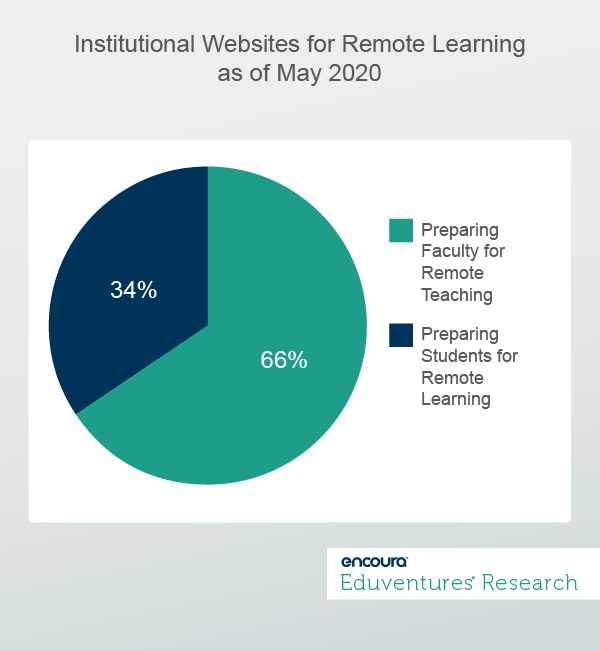As institutions turn from the emergency delivery of remote instruction to scenario planning for the fall semester, many are looking at how they can increase the quality of their online delivery in the event it continues to be needed. For “real” online learning, institutions will need to ensure that they place student needs, or student-centeredness, at the center of their approaches.
Our research into how institutions are responding to COVID-19 suggests that most leaders are only beginning to make this pivot. The good news is that some institutions offer great examples of how to proceed toward student-centeredness. Here are three of them.
Student-Centeredness in Current Institutional Responses
First, to get a deeper sense of evolving practice, we reviewed the institutional websites devoted to preparing for the move to remote learning. These sites signaled which audiences, resources, and strategies institutions considered essential.
Using web scraping technology and the list of remote teaching resource websites managed by Daniel Stanford at DePaul University, we developed a list of 530 websites, including both academic continuity plans and webpages of resources and recommendations, across 371 institutions. For inclusion in our analysis, the website had to be clearly driven by COVID-19, not a preexisting website from a school that already had online classes. We culled out the few websites we found from online-focused schools.
As shown in Figure 1, the central focus of these websites fell into two broad categories, based on the primary intended audience of each:
- “Keep teaching”: Most institutional websites (66%) were primarily directed toward a faculty audience, intended to help prepare them for remote learning. These mainly focused on the logistics and solutions needed for remote teaching: operating video conferencing solutions, moving content to the learning management system (LMS), and how to use LMS assessment capabilities to deliver and review exams.
- “Keep learning”: Fewer websites (34%) were primarily intended to reach students. These highlighted how students—regardless of their range of hearing, movement, sight, and cognitive abilities—could access and manage digital materials, engage with faculty remotely, and access advisors and faculty for academic support.
Notably, a small handful (10 or less) did address both audiences. These were categorized based on which audience was primary.

Of the third of schools that are actively preparing students for remote learning, Our research uncovered three institutions that show a particularly strong commitment to student-centeredness, notably in the areas of access to digital resources, engagement, and student support:
- Access to digital resources: Often overlooked among institutions prioritizing student access to digital resources (logging into conferencing software, for example) is the additional help students with disabilities might need. Most accessibility guidelines focus on what faculty should do. The guidance provided by the University of Alabama is an excellent example of going beyond merely informing, by providing their instructors with methods for checking materials for accessibility (using tools such as Blackboard Ally or Adobe Acrobat Pro Accessibility Checker).
- Engagement with faculty and staff: Most institutions that provide guidance in this area identify tactics to enable communication between students, faculty, and staff through learning management systems (LMS) or other technologies. Barnard College, however, also details how best to lay the ground work for student-faculty engagement by establishing clear learning objectives and collecting student feedback about the remote learning experience.
- Access to academic support: As with student engagement, institutions often jump right to the tactics students can use to seek support, such as understanding advisors’ office hours. Auburn University, however, expands its guidance to include steps for students to get writing help, academic coaching, and study partners. Surprisingly, Auburn is a rare example of including information on how to get library support via live chat with librarians.
The Bottom Line
We understand that a point-in-time review of institutional pandemic responses and remote instructional plans may present an incomplete picture. Institutions put these plans together in a hurry, and our analysis only represents a snapshot of the current state of institutional strategies for remote learning. Future investigations may uncover greater focus on positioning students for success as fall planning unfolds.
The three institutions highlighted here, however, are indicative of an important pivot that many schools are beginning to make from the tactical aspects of remote learning (which tools to use) to a more holistic approach to student-centeredness and faculty readiness—a reminder that quality online learning is first about the “who” and then about the “how.” Going forward, discussions about remote instruction should concentrate on how best to deliver value to students in addition to the best technology solutions to use.

Never
Miss Your
Wake-Up Call
Learn more about our team of expert research analysts here.
Eduventures Principal Analyst at Encoura
Contact
Thursday, June 11, 2020 at 1PM ET/12PM CT
For higher education leaders, planning for fall is never straightforward but nothing is certain about fall 2020. The severity of the pandemic, whether campuses can re-open and under what restrictions, student appetite for remote alternatives, and the state of institutional finances are dynamic unknowns forcing schools to plan for the most pivotal moment in the academic year largely in the dark. But schools need to make decisions and they need to make them now. Higher education leaders want to understand student sentiment but students look to schools for clarity on what fall will look like.
Certainty may be in short supply but sharing ideas and perspectives can only help. Join us for a conversation with Neumann University President Chris Domes, Simmons University President Helen Drinan, and Eduventures Chief Research Officer Richard Garrett. These institutions have worked hard to stand up remote instruction over the past two months and are now piecing together fall plans that must be realistic, sustainable and appealing to students, faculty and staff.

